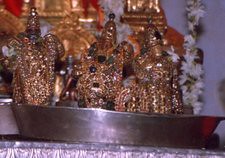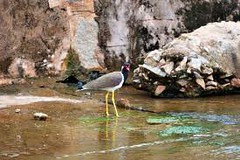
There are six chakras in the human body . So says Brihadaranya upanishad . These chakras are sukshma kendras where Lord resides to control various koshas of the body .The various koshas are , annamaykosha , pranamay kosha , manomay kosha etc ….
The first chakra is mooladhara situated at the point called kanda which is 2inches above the rectum[between anus guda and vrushana testicles ] , it is 4 inches by two inches spherical. ABOVE this kanda is situated a four petals of LOTUS encompassing a TRIKONA AGNI mandal . [ Triangular basin of fire ] The beejaakshar LAM activates this chakra .
The second chakra is MANIPURA situated at the navel [ nabhi] . It is LOTUS of eight petals , encompassing a vayu mandal in shatkona [ hexagon ]. yam is the beejakshar
The third chakra is of anahat [ hruday chakra ] it consists of eight petals of LOTUS encompassing surya mandal of dwadashkona [ 12 side polygon ] . rum is the beejakshar
The fourth chakra is in vishuddha INDRAYONI [ near the backside of the tongue ] ,This eight petal LOtus with spherical chandra mandal . ham is the beejakshar.
The fifth is brumadhya chakra of agnya [ forehead ] it consists of two petals of LOTUS with trikona agni mandal . varun beeja is the akshar .
The sixth is 12inches above head is sahasrar chakra , it consists of 1000 petals of LOTUS inside six petals at base moordhni and spherical budha mandal . OM is the beejakshar . turiya is the rupa .
The first three chakras are red in colour and rest are white in colour .
Vasudev etc five rupas o the LORD should be meditated in each chakra .
Vasudev is white in color ,sankarshana is pingala in color , pradyumna is harita in color , aniruddha is neela in color , Narayana is lohita in color .
The mooladhara consists of sushumna which rises till the bramharandra in the head , this is made up of five nadis ie vajrika , arya, avabhasini ,vaidhruta , bramhanadi .
Sushumna[ Narayana ] is surrounded by IDA[ Aniruddha ] to the left PINGALA [ sankarshana] to the right DHARINI[ vasudeva ] in front and VAJRIKA [ Pradyumna ] in back .
Without seeing the LORD there cannot be moksha . To see him one must engage in shravan manan and after getting his complete knowledge then one can engage in DHYANA and not before that .
There are two types of upasana : Adhyayan Adhyapan is one and DHYAN is second .
DHYAN has limbs like yama niyama asana pranayama .
Pratyahaar dharana dhyan samadhi are for aparoksha ,
Yama means satya asteya ahimsa bramhacharya aparigraha .
Shouch tapasya trupti svadhyaya Haripooja all these are Niyamas .
Svastikaasan , Veerasana , padmasan etc are asanasa .
YagnyaValkya says , not troubling anyone by speech mind and body is known as AHIMSA.
satyam bhutahitam proktam na yatartha bhashanam .
TRUTH is what is beneficial to satvikas and not speaking as is .
Not aspiring[ body and mind and speech ] others wealth and belongings is what is ASTEYA .
Completely avoiding thoughts of sex with women by body mind and speech is what is known as BRAMHACHARYA .
Aparigraha : totally isolating self from the worldly pursuits of money mongering and gossip .
Shouch – two types , bahya / antar . CLEANING the body with water soaps and other cosmetics is bahya shouch . restricting mind from anger lust etc is antah shauch .
Tapasya – concentration[ ekagrata ] of mind and chitta and indriyas is known as tapasya .
ASAN – devata smaran can be done in any position , but dhyana should be in the asana only . if body is fragile , so is mind ,so to get steadfast mind , asan is necessary . PADMASAN is best .
Pranayam ; Rechak poorak and kunbhak are three parts of PRANAYAMA . If pranayam is done without mantra then it becomes preparatoryfor dhyana , if done with mantra and devta smarana [ VISNUM VAYUM SMARET ] then it becomes dhyana itself ,
For MUKTI sadhana shravan is important . those who donot know tattva they must listen to shastras only . Those who have learnt shastra they must do manana to consolidate their learnings , Those who have consolidated the shastras must do dhyana .
BUT Shastra vimarsha [ contemplation ] is 10 times more better than dhyana . ANd hundred times better is teaching atleast one student . EVEN aparokshagyanis teach because HARI is pleased by teaching of shastras ,
In dhyan only few gunas of HARI is what meditated , but while shastra vimarsha there is opportunity to contemplate many qualities of LORD .
SHAUCH and ASAN are means to MOKSHA SADHANA but they themselves are not sadhana so much importance and time should not be spent on only making asanas and shuchi .Otherwise people spend hours in sculpting body with yogasanas .These dont even give punya by themselves ,
Pranayam , aparigraha , ahimsa ,satya, asteya , bramhacharya , tushti among these , each is greater than other by two times . Shastrabhyasa is one crore times greater . HARIPOOJA is infinite times greater than these . DHYANA is three times better . SHATRA vimarsha and pravachana is manyfolds greater than DHYANA .
One must practise PRANAYAMA for more and more times . One must remove the inner air through pingala and take in fresh air through IDA and hold it in sushumna and then remember VISHNU and VAYU .
If there is break while doing such VISHNU samrana then it is dharana , if there is no breaks and if it is continous than it is DHYANA . if outer world totally elapses for a sadhak then it is samadhi . SUCH prolonged samadhi gives aparoksha , COntinuous shastra parisheelana [ contemplation also gives aparoksha ] . This should be accompanied by devotion only then aparoksha is possible ,. Affection full of DIVINE KNOWLEDGE of shastras is what known as devotion BHAKTI , This BHAKTI alone is important for MOKSHA .
krishnarpanamastu
0.000000
0.000000







Notes & comments